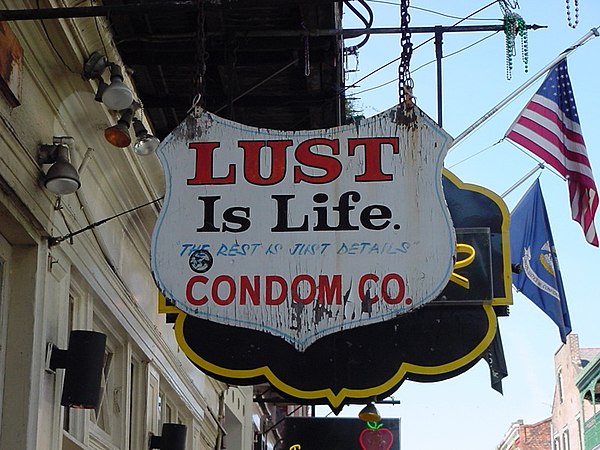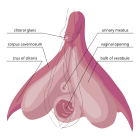Portal:Human sexuality
| Main page | Recognized content | Subcategories |
Welcome to the human sexuality portal
Human sexuality is the way people experience and express themselves sexually. This involves biological, psychological, physical, erotic, emotional, social, or spiritual feelings and behaviors. Because it is a broad term, which has varied with historical contexts over time, it lacks a precise definition. The biological and physical aspects of sexuality largely concern the human reproductive functions, including the human sexual response cycle.
Someone's sexual orientation is their pattern of sexual interest in the opposite and/or same sex. Physical and emotional aspects of sexuality include bonds between individuals that are expressed through profound feelings or physical manifestations of love, trust, and care. Social aspects deal with the effects of human society on one's sexuality, while spirituality concerns an individual's spiritual connection with others. Sexuality also affects and is affected by cultural, political, legal, philosophical, moral, ethical, and religious aspects of life.
Interest in sexual activity normally increases when an individual reaches puberty. Although no single theory on the cause of sexual orientation has yet gained widespread support, there is considerably more evidence supporting nonsocial causes of sexual orientation than social ones, especially for males. Hypothesized social causes are supported by only weak evidence, distorted by numerous confounding factors. This is further supported by cross-cultural evidence, because cultures that are tolerant of homosexuality do not have significantly higher rates of it.
Evolutionary perspectives on human coupling, reproduction and reproduction strategies, and social learning theory provide further views of sexuality. Sociocultural aspects of sexuality include historical developments and religious beliefs. Some cultures have been described as sexually repressive. The study of sexuality also includes human identity within social groups, sexually transmitted infections (STIs), and birth control methods. (Full article...)
Selected article
The clitoris is the human female's most sensitive erogenous zone and generally the primary anatomical source of human female sexual pleasure. In humans and other mammals, it develops from an outgrowth in the embryo called the genital tubercle. Initially undifferentiated, the tubercle develops into either a penis or a clitoris, depending on the presence or absence of the protein tdf, which is codified by a single gene on the Y chromosome. The clitoris is a complex structure, and its size and sensitivity can vary. The glans (head) of the human clitoris is roughly the size and shape of a pea, and is estimated to have more than 8,000 sensory nerve endings. (Full article...)
Selected image

Did you know



- ... that loans made by Seattle brothel-owner Lou Graham saved some of the city's most prestigious families from bankruptcy after the Panic of 1893? (former brothel pictured)
- ... that Monica Coghlan, at the center of the scandal surrounding Lord Jeffrey Archer, was killed in an unrelated car crash a month before the start of the trial that would convict him of perjury and vindicate her?
- ... the Śukasaptati, written originally in Sanskrit, is a collection of seventy erotic tales narrated by a parrot to prevent its mistress from committing adultery while her husband is away from home?
- ... that the fictional Document 12-571-3570 was a hoax that purported to describe sex experiments done in space?
- ... that anti-gay protests following the selection of the song Samo Ljubezen by drag-group Sestre (pictured) in the 2002 Eurovision Song Contest led to criticism of Slovenia in the European Parliament?
- ... that the monument (pictured) to Mother Featherlegs near Lusk, Wyoming has been called the only monument to a prostitute in the United States?
- ... that studies on whether nice guys finish last have been hindered by the social desirability bias?
- ... that American novelist Tracy Quan once served as spokeswoman to the sex worker advocacy group Prostitutes of New York?
July-December 2006
Human sexuality in the news
- 12 November 2024 – Anglican Communion sexual abuse cases
- Justin Welby, the Archbishop of Canterbury and the symbolic head of the Anglican Communion, resigns over his handling of barrister John Smyth's sex abuse scandal. (NPR) (AP)
- 11 November 2024 –
- The International Criminal Court announces an investigation into prosecutor Karim Ahmad Khan over accusations of sexual misconduct previously reported by The Guardian in October. (BBC News) (The Guardian)
- 5 November 2024 –
- Equatoguinean vice-president Teodoro Nguema Obiang Mangue warns that politicians caught having sex in their offices could face harsh consequences after a civil servant was caught having sex with multiple women while on the job. (BBC News)
Get involved
For editor resources and to collaborate with other editors on improving Wikipedia's Human sexuality-related articles, see WikiProject Sexology and sexuality.
Topics
Tasks

- Cleanup listing for WikiProject Sexology and sexuality — bot-generated list of articles within the scope of this WikiProject tagged as needing attention
- Cleanup listing for WikiProject LGBT studies — bot-generated list of articles within the scope of this WikiProject tagged as needing attention
Related portals
Associated Wikimedia
The following Wikimedia Foundation sister projects provide more on this subject:
-
Commons
Free media repository -
Wikibooks
Free textbooks and manuals -
Wikidata
Free knowledge base -
Wikinews
Free-content news -
Wikiquote
Collection of quotations -
Wikisource
Free-content library -
Wikiversity
Free learning tools -
Wiktionary
Dictionary and thesaurus





















